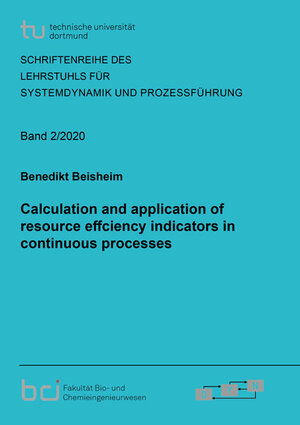
×
![Buchcover ISBN 9783844075236]()
Calculation and application of resource effciency indicators in continuous processes
von Benedikt BeisheimThe industry in Europe faces ambitious future challenges. While raw materials and energy are more expensive than in many other parts of the world, political frameworks and agreements are placing additional pressure on the competitiveness of the industry. Therefore, the resource-efficient production is a prerequisite for maintaining the competitiveness of European production sites. Evaluating the resource efficiency of a process requires a suitable set of indicators that can be used to monitor a process and identify sub-optimal operating points.
In this thesis, resource efficiency indicators are developed that are suitable for monitoring a process in real-time. For that, principles are developed that an indicator must meet in order to be suitable for its intended use. In order to provide a meaningful basis for the interpretation of the indicator, a method for identifying the best performance of a process under the given conditions, such as the outside temperature or the capacity utilization of the plant is presented.
Real-time resource efficiency indicators are most effectively used for plants or plant sections, as then variations in the performance can easily be analyzed. But such indicators can conflict with high level indicators at site level. In order to avoid this, a method is presented to aggregate real-time performance indicators from lower levels of the hierarchy to higher levels. In this way, the consistency of indicators can be maintained at any hierarchical layer.
The concepts were implemented as part of a resource efficiency dashboard at the production site of INEOS in Cologne. The evaluation of the results after one year of use show significant improvements in the process in terms of resource efficiency. The description of the application and the evaluation can also be found in this thesis.
In this thesis, resource efficiency indicators are developed that are suitable for monitoring a process in real-time. For that, principles are developed that an indicator must meet in order to be suitable for its intended use. In order to provide a meaningful basis for the interpretation of the indicator, a method for identifying the best performance of a process under the given conditions, such as the outside temperature or the capacity utilization of the plant is presented.
Real-time resource efficiency indicators are most effectively used for plants or plant sections, as then variations in the performance can easily be analyzed. But such indicators can conflict with high level indicators at site level. In order to avoid this, a method is presented to aggregate real-time performance indicators from lower levels of the hierarchy to higher levels. In this way, the consistency of indicators can be maintained at any hierarchical layer.
The concepts were implemented as part of a resource efficiency dashboard at the production site of INEOS in Cologne. The evaluation of the results after one year of use show significant improvements in the process in terms of resource efficiency. The description of the application and the evaluation can also be found in this thesis.


